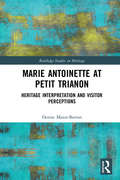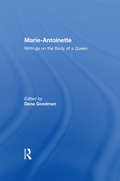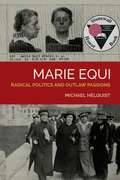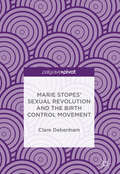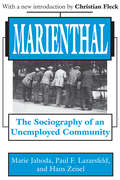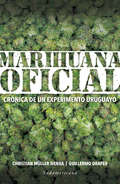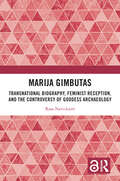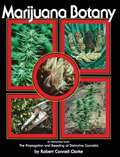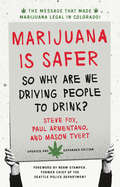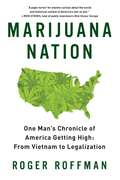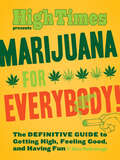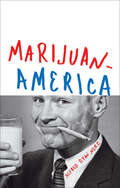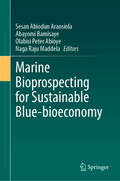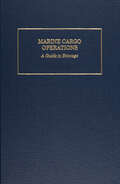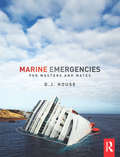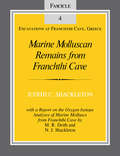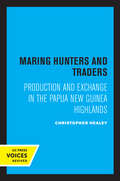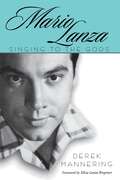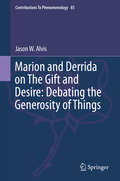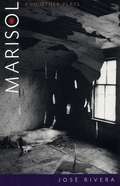- Table View
- List View
Marie Antoinette at Petit Trianon: Heritage Interpretation and Visitor Perceptions
by Denise Maior-BarronMarie Antoinette at Petit Trianon challenges common perceptions of the last Queen of France, appraising the role she played in relation to the events of French Revolution through an original analysis of contemporary heritage practices and visitor perceptions at her former home, the Petit Trianon. Controversy and martyrdom have placed Marie Antoinette’s image within a spectrum of cultural caricatures that range from taboo to iconic. With a foundation in critical heritage studies, this book examines the diverse range of contemporary images portraying Marie Antoinette’s historical character, showing how they affect the interpretation and perception of the Petit Trianon. By considering both producers and receivers of these cultural heritage exponents - Marie Antoinette’s historical figure and the historic house museum of the Petit Trianon - the book expands current understandings of twenty-first century cultural heritage perceptions in relation to tourism and popular culture. A useful case study for academics, researchers and postgraduate students of cultural heritage, it will also be of interest to historians, keepers of house museums and those working in the field of tourism studies.
Marie Antoinette: Writings on the Body of a Queen
by Dena GoodmanMarie-Antoinette is one of the most fascinating and controversial figures in all of French history. This volume explores the many struggles by various individuals and groups to put right Marie's identity, and it simultaneously links these struggles to larger destabilizations in social, political and gender systems in France.Looking at how Marie was represented in politics, art, literature and journalism, the contributors to this volume reveal how crucial political and cultural contexts were enacted "on the body of the queen" and on the complex identity of Marie. Taken together, these essays suggest that it is precisely because she came to represent the contradictions in the social, political and gender systems of her era, that Marie remains such an important historical figure.
Marie Equi: Radical Politics and Outlaw Passions
by Michael HelquistMarie Equi explores the fiercely independent life of an extraordinary woman. Born of Italian-Irish parents in 1872, Marie Equi endured childhood labor in a gritty Massachusetts textile mill before fleeing to an Oregon homestead with her first longtime woman companion, who described her as impulsive, earnest, and kind-hearted. These traits, along with courage, stubborn resolve, and a passion for justice, propelled Equi through an unparalleled life journey. Equi self-studied her way into a San Francisco medical school and then obtained her license in Portland to become one of the first practicing woman physicians in the Pacific Northwest. From Pendleton, Portland, Seattle and beyond to Boston and San Francisco, she leveraged her professional status to fight for woman suffrage, labor rights, and reproductive freedom. She mounted soapboxes, fought with police, and spent a night in jail with birth control advocate Margaret Sanger. Equi marched so often with unemployed men that the media referred to them as her army. She battled for economic justice at every turn and protested the U. S. entry into World War I, leading to a conviction for sedition and a three-year sentence in San Quentin. Breaking boundaries in all facets of life, she became the first well-known lesbian in Oregon, and her same-sex affairs figured prominently in two U. S. Supreme Court cases. Marie Equi is a finely written, rigorously researched account of a woman of consequence, who one fellow-activist considered "the most interesting woman that ever lived in this state, certainly the most fascinating, colorful, and flamboyant. " This much anticipated biography will engage anyone interested in Pacific Northwest history, women's studies, the history of lesbian and gay rights, and the personal demands of political activism. It is the inspiring story of a singular woman who was not afraid to take risks, who refused to compromise her principles in the face of enormous opposition and adversity, and who paid a steep personal price for living by her convictions.
Marie Stopes’ Sexual Revolution and the Birth Control Movement
by Clare DebenhamThis book examines the life, work and contraversial achievements of Marie Stopes, author and pioneer of the birth control movement in the interwar period. As the centenary of the ground-breaking publication of Married Love approaches, this study traces and reassesses Marie’s remarkable achievements, considering the literary, scientific and political themes of her life’s work. Clare Debenham analyses how Stope’s personal life led her to turn away from palaeobotany to concentrate on transforming the country’s sexual relationships by writing Married Love. Utilising extensive unpublished archive research, biographies, letters, and interviews with her friends and relatives, Debenham demonstrates that Stopes's work on sexual relationships has overshadowed her considerable achievements including her scientific career as a paleaobotantist, her literary success in the interwar period, and her work, with help from suffragists, in establishing the first British birth control clinic.
Marienthal: The Sociography of an Unemployed Community
by Paul F. Lazarsfeld Marie Jahoda Hans Zeisel"One of the main theses of the Marienthal study was that prolonged unemployment leads to a state of apathy in which the victims do not utilize any longer even the few opportunities left to them. The vicious cycle between reduced opportunities and reduced level of aspiration has remained the focus of all subsequent discussions." So begin the opening remarks to the English-language edition of what has become a major classic in the literature of social stratification.
Marihuana oficial: Crónica de un experimento uruguayo
by Christian Muller Guillermo DraperLa historia de un experimento que quedará para la historia, tanto si tiene éxito como si fracasa. Desde que José Mujica recorrió cuarteles para ver dónde podía plantar marihuana hasta que el cannabis echó raíces en un predio estatal pasaron más de tres años y una elección. La venta de la droga en farmacias completa un sistema único que rompe con décadas de prohibición y le disputa al narcotráfico uno de sus mercados.Una investigación periodística con más de cuarenta entrevistados, Marihuana oficial cuenta qué llevó al gobierno de Uruguay a embarcar a un pequeño país en un viaje desconocido. En sus páginas hay narcos, policías, activistas, políticos, empresarios y exguerrilleros; los protagonistas de un experimento que quedará en la historia si tiene éxito y también si fracasa.Desde que José Mujica recorrió cuarteles para ver dónde podía plantar marihuana hasta que el cannabis echó raíces en un predio estatal pasaron más de tres años y una elección. La venta de la droga en farmacias completa un sistema único que rompe con décadas de prohibición y le disputa al narcotráfico uno de sus mercados.Una investigación periodística con más de cuarenta entrevistados, Marihuana oficial cuenta qué llevó al gobierno de Uruguay a embarcar a un pequeño país en un viaje desconocido. En sus páginas hay narcos, policías, activistas, políticos, empresarios y exguerrilleros; los protagonistas de un experimento que quedará en la historia si tiene éxito y también si fracasa.
Marija Gimbutas: Transnational Biography, Feminist Reception, and the Controversy of Goddess Archaeology
by Rasa NavickaitėThis book is a biography and reception history of the Lithuanian–American archaeologist Marija Gimbutas (1921–1994). It presents the first transnational account of Gimbutas’ life based on historical research, and an original examination of the impact of her ideas in various feminist contexts, both academic and popular. At the core of this book is a success story of an Eastern European woman who survived both Soviet and Nazi occupations of her homeland, lived as a displaced person in postwar Germany, and built her career and scholarly authority within the androcentric American academia. At the same time, it is also a story of a controversy, which followed Gimbutas’ theory of Old Europe – a prehistoric civilization, characterized by peacefulness, egalitarianism, women’s leadership, and the worship of the Great Goddess. First introduced in 1974, this theory inspired women’s movements worldwide, but was harshly criticized by other archaeologists. This book examines the various intellectual contexts (feminist, nationalist, theoretical) in which Gimbutas’ ideas were formed, received, and interpreted, as well as appropriated for different political goals. This timely study will appeal to scholars and students in the following fields: history of archaeology, prehistoric archaeology, gender studies, feminist studies, women’s history, Baltic studies, and religion and spirituality.
Marijuana Botany
by Robert Connell ClarkeMarijuana Botany presents the scientific knowledge and propagation techniques used to preserve and multiply vanishing Cannabis strains. Also included is information concerning Cannabis genetics and breeding used to begin plant improvement programs. The book presents scientific and horticultural principles, along with their practical applications, necessary for the breeding and propagation of Cannabis and in particular, marijuana. It will appeal not only to the professional researcher, but to the marijuana enthusiast or anyone with an eye to the future of Cannabis products.
Marijuana Cooking
by Veronica Green Bliss CameronIn Marijuana Cooking: Good Medicine Made Easy, authors Bliss Cameron and Veronica Green guide would-be chefs through the process of making their own tasty and healthy home-remedies using marijuana. Step-by-step instructions and photographs carefully document the cooking techniques described, making this the most user-friendly marijuana cookbook available.Increasing awareness of the therapeutic properties of marijuana--to ease tension in the body, relieve pain and pressure, promote appetite, and induce overall relaxation--has generated widespread interest in its use as a medicine. Without doubt, the best and safest medicinal application of marijuana is ingestion.What makes this book truly unique is the careful attention paid to the individual needs of those who rely on the therapeutic properties of marijuana. The authors offer five ways to prepare marijuana for use in the kitchen, advice on personalizing dosage, and tips on substituting ingredients to account for different tastes and medical conditions.Cameron and Green understand that marijuana is good medicine for both the body and spirit. They have long been involved in providing healthy marijuana treats to individuals suffering from ailments such as arthritis, asthma, insomnia, appetite loss, and glaucoma, and others who rely on the soothing and therapeutic benefits of marijuana.
Marijuana Is Safer
by Steve Fox Paul Armentano Mason TvertNationally recognized marijuana-policy experts Steve Fox, Paul Armentano, and Mason Tvert compare and contrast the relative harms and legal status of the two most popular recreational substances in the world--marijuana and alcohol. Through an objective examination of the two drugs and the laws and social practices that steer people toward alcohol, the authors pose a simple yet rarely considered question: Why do we punish adults who make the rational, safer choice to use marijuana instead of alcohol?Marijuana Is Saferreaches for a broad audience. For those unfamiliar with marijuana, it provides an introduction to the cannabis plant and its effects on the user, and debunks some of the government's most frequently cited marijuana myths. For current and aspiring advocates of marijuana-law reform, as well as anyone else who is interested in what is becoming a major political battle, the authors spell out why the message that marijuana is safer than alcohol must be a prominent part of the public debate over legalization. Most importantly, for the millions of Americans who want to advance the cause of marijuana-policy reform--or simply want to defend their own personal, safer choice--this book provides the talking points and detailed information needed to make persuasive arguments to friends, family, coworkers, and elected officials.
Marijuana Medicine: A World Tour of the Healing and Visionary Powers of Cannabis
by Christian RätschA comprehensive survey of the therapeutic, historical, and cultural uses of cannabis in traditions around the world.• The most complete visual record of cannabis culture ever published.• Christian Ratsch is one of the world's foremost ethnopharmacologists and is the current president of the German Society for Ethnomedicine. Marijuana Medicine explores the role of hemp in medicinal systems spanning the globe. Cannabis has accompanied the development of human culture from its very beginnings and can be found in the healing traditions of cultures throughout Africa, Asia, Europe, and the Americas. Even today it is an important part of many Asian healing traditions: in Ayurveda cannabis is praised for its tonic and aphrodisiac qualities and in traditional Chinese medicine it is cited as a superb antidepressant. It also remains a significant part of the healing and visionary traditions of Latin American curanderos and Brazilian, Nepalese, and Indian folk medicine. Modern research has confirmed the effectiveness of marijuana's application in treating such diseases as asthma and glaucoma. Christian Ratsch profiles the medicinal, historical, and cultural uses of cannabis in each of these societies and medical systems, providing remedies and recipes for those interested in how cannabis can be used to treat specific conditions.
Marijuana Nation: From Vietnam to Legalization
by Roger RoffmanFor Roger Roffman, a retired university professor, there's nothing academic in the stories told in his memoir. It was personal when Roffman struggled with his own compulsive pot use and when he lost his younger brother to a drug overdose. It's personal when he challenges those who say marijuana is harmless. It's personal when he asks: If criminal penalties have been ineffective in protecting young people and the public's health and safety, might a well-designed and well-regulated legal market do better? For 45 years, Roffman has worn a multitude of hats, all related to his fascination with marijuana: the first to survey soldiers about their pot use in Vietnam, activist working to reform the laws, federally-funded marijuana dependence researcher, addiction therapist, drug educator, and - for a while - even a dealer who helped cancer patients learn about pot. It began in Vietnam where, as an Army officer in 1967, he questioned the prison terms meted out to soldiers who got high, while at every military base in the country booze was cheap and readily available. Roffman has experienced the layered and complex relationship Americans have with marijuana first-hand. His stories offer all too rare balanced insights about a drug that directly or indirectly has affected virtually all of us living in Marijuana Nation.
Marijuana Success Indoors
by Ed RosenthalMarijuana Success Indoors looks into the gardens of real people to see how they have combined gardening skill with technological savvy to produce quality buds. This large-format, 8.5 x 11 inch book focuses on homegrowing cultivation issues and solutions, including working in small spaces, the use of hydroponics versus planting mix gardens, lighting, and supplementing with CO2. A great companion to information found in grow guides Marijuana Success Indoors shows what types of problems are encountered in actual gardening situations, and how they are addressed to result in success.
Marijuana Success Indoors: Garden Tours and Tips
by Ed RosenthalMarijuana Success Indoors looks into the gardens of real people to see how they have combined gardening skill with technological savvy to produce quality buds. This large-format, 8.5 x 11 inch book focuses on homegrowing cultivation issues and solutions, including working in small spaces, the use of hydroponics versus planting mix gardens, lighting, and supplementing with CO2. A great companion to information found in grow guides Marijuana Success Indoors shows what types of problems are encountered in actual gardening situations, and how they are addressed to result in success.
Marijuana for Everybody!: The Definitive Guide to Getting High, Feeling Good, and Having Fun
by Elise McDonough High Times“A surprisingly deep guide to pot culture . . . 192 pages of legit knowledge” from the author of The Official High Times Cannabis Cookbook (The Cannabist).Marijuana is more widely available and accepted than ever before, with more people coming to the plant every day for a range of reasons. From the experts at High Times magazine—the world’s most trusted name when it comes to getting stoned—here is an authoritative, accessible guide to marijuana, its uses, and culture. This illustrated handbook offers clear and friendly primers on subjects such as what pot is and how it works, tips on getting high and managing the experience, cooking with pot, and FAQs as well as an “I’m High, Now What?” selection of activities and amusements for the freshly baked. Part manifesto, part party invitation, Marijuana for Everybody! is an informative and entertaining read for the uninitiated and practiced users alike.“The rapidly advancing world of weed gets broken down into easy chunks on topics like ‘cannabis chemistry,’ ‘how to: roll the classic cone,’ and ‘where do bongs come from?’ . . . The list-lovers will dig: 8 items to look for on the label when you buy legal weed; 6 things to do if you think you’re too high; 7 things to keep in mind when buying edibles; and 10 common marijuana strains and their characteristics.” —Smell the Truth“Well-written, carefully researched and incredibly thorough . . . If you have even a passing interest in marijuana, start clearing a space between your grinder and bong for this book on your coffee table.” —Willamette Week
Marijuanamerica: One Man's Quest To Understand America's Dysfunctional Love Affair With Weed
by Alfred Ryan Nerz“A delightfully weird . . . journey that includes crazed pharmacists, a guy named Buddha Cheese, and an interstate road trip with a trunk full of pot.” —A. J. Jacobs, New York Times–bestselling authorAlfred Ryan Nerz is a Yale-educated author, journalist, and TV producer. He’s also a longtime marijuana enthusiast who has made it his mission to better understand America’s long-standing love-hate relationship with our favorite (sometimes) illegal drug. His cross-country investigation started out sensibly enough: taking classes at a cannabis college, hanging out with a man who gets three hundred pre-rolled joints per month from the federal government, and visiting the world’s largest medical marijuana dispensary. But his journey took an unexpected turn and he found himself embedded with one of the largest growers and dealers on the West Coast. He quickly transformed into an underworld apprentice—surrounded by pit bulls, exotic drugs, beanbags full of cash, and trunks full of weed. But while struggling to navigate the eccentric characters and rampant paranoia of the black market, he maintained enough equanimity to explore a number of vital questions: Is marijuana hurting or helping us? How is it affecting our lungs, our brains, and our ambitions? Is it truly addictive, and if so, are too many of us dependent on it? Should we legalize it? Does he need to quit? As entertaining as it is illuminating, Marijuanamerica is one man’s attempt to humanize the myriad hot-button topics surrounding the nation’s obsession with weed, while learning something about himself along the way.“These wacky accounts rival T.C. Boyle’s fine novel Budding Prospects in showing the highly misguided paranoia that can be cured—or accentuated—by consumption of the marijuana plant’s sticky blossoms.” —Pasatiempo
Marine Bioprospecting for Sustainable Blue-bioeconomy
by Naga Raju Maddela Sesan Abiodun Aransiola Olabisi Peter Abioye Abayomi BamisayeThis volume comprehensively discusses marine bioprospecting and its applications in the marine bioeconomy, specifically in clean energy generation, and in biomedical, industrial and agricultural sectors. The advent of modern technology, particularly advancements in deep-sea exploration and biotechnology, has enabled scientists to delve deeper into the ocean's depths and discover a treasure trove of unique organisms and compounds. This demonstrates that the rich history of human interactions with the oceans is firmly ingrained in marine bioprospecting. The blue-economy, which is a more accurate name for the systematic search for valuable substances and organisms in the water, has gained popularity in recent years as a possible route for sustainable economic development. One of the key driving factors behind marine bioprospecting is the growing realization that marine organisms possess unique biochemical compounds with the potential to revolutionize various industries. These compounds include novel enzymes, antimicrobial agents, bioactive molecules, and even potential pharmaceuticals. Readers will learn about the applications of these discoveries in bioremediation, wastewater treatment, and biofuel production, as well as the identification of natural substitutes for things that are detrimental to the environment, which include biodegradable plastics derived from marine microorganisms. The primary audience for the book will be governmental and international organizations, professionals, and economists, while the secondary audience will be professors and researchers in the fields of Chemistry, Biotechnology, Environmental Microbiology, and general Ocean Sciences.
Marine Cargo Operations
by Robert J. MeurnMarine Cargo Operations clearly spells out the basic principles of cargo operations and acquaints merchant officers with the techniques of stowage and their application. Based on the authors’ half century of experience, the book singles out the most practical methods, procedures, and philosophies and presents them in thorough detail. Each discussion is enhanced by photographs or drawings. The book provides a complete understanding of the shipping cycle so all associated personnel can work as a team in observing the “three Cs” of shipping: communication, cooperation, and coordination. The third edition emphasizes containerization and the responsibilities of the ship’s officers for the proper and safe carriage of their cargo. The chapter on cargo responsibility has been updated by an admiralty lawyer, and a new chapter, “Stowage of Containers,” has been written by a ship’s master with thirty years of containership experience. The National Cargo Bureau furnished a chapter on stowage of grain bulk cargo. Also included are discussions on breakbulk cargo and how the ship’s officer can prevent condensation or moisture damage, the most common cause of cargo damage claims. This edition provides vital information and questions and answers for candidates taking a U.S. Merchant Marine license examination, and is an important refresher for those who have already received their licenses.
Marine Emergencies: For Masters and Mates
by David HouseAn influential guide to maritime emergencies and the current strategies that can be employed to cope with the immediate after effects and ramifications of disaster at sea. Many mariners will at some point in their maritime careers become involved in one sort of emergency or another, while in port or at sea, whether it is a fire on board, a collision with another vessel or an engine failure threatening a lee shore. Actions to take in such incidents can be the difference between survival and catastrophic loss. This text provides a direct insight into some of the latest incidents and includes: case studies from emergencies worldwide checklists and suggestions for emergency situations. everything from fire and collision right through to the legal implications of salvage. David House has now written and published eighteen marine titles, many of which are in multiple editions. After commencing his seagoing career in 1962, he was initially engaged on general cargo vessels. He later experienced worldwide trade with passenger, container, Ro-Ro, reefer ships and bulk cargoes. He left the sea in 1978 with a Master Mariner's qualification and commenced teaching at the Fleetwood Nautical College. He retired in 2012 after thirty three years of teaching in nautical education. He continues to write and research maritime aspects for future works.
Marine Molluscan Remains from Franchthi Cave: Fascicle 4, Excavations at Franchthi Cave, Greece (Excavations at Franchthi Cave, Greece #No. 4)
by Judith C Shackleton... the archaeological and paleoenvironmental data from Franchthi Cave are unique in providing a site-specific record of the cultural responses to great environmental changes." —Quarterly ResearchThe marine molluscan material covered here is the largest sample of its kind yet excavated in Greece.
Marine Tourism: Development, Impacts and Management (Routledge Advances in Tourism)
by Mark OramsMarine Tourism examines both successful and unsuccessful tourism in coastal and marine environments. The author provides an overview of the history, development and growth of marine tourism and describes the characteristics of 'marine tourists' and the 'vendors' of these tourist activities. The book includes case studies of specific types of tourism including:* the cruise ship industry, * whale and dolphin watching,* yachting - the America's Cup,* personal water crafts and other water sports* and maritime museums and festivals. in locations including Brighton, UK, the Florida Keys and Hawaii, USA Caribbean islands, New Zealand and Australia's Great Barrier Reef. The final section examines tourism impacts on marine ecosystems and coastal communities and explores management techniques aimed at reducing negative impacts and maximizing the benefits of marine tourism.
Maring Hunters and Traders: Production and Exchange in the Papua New Guinea Highlands (Studies in Melanesian Anthropology #8)
by Christopher HealeyThis title is part of UC Press's Voices Revived program, which commemorates University of California Press’s mission to seek out and cultivate the brightest minds and give them voice, reach, and impact. Drawing on a backlist dating to 1893, Voices Revived makes high-quality, peer-reviewed scholarship accessible once again using print-on-demand technology. This title was originally published in 1990.
Mario Lanza: Singing to the Gods (American Made Music Series)
by Derek ManneringBlessed with one of the great tenor voices of all time, Mario Lanza (1921-1959) rose to spectacular heights in a film, recording, and concert career that spanned little more than a decade. Groomed at the outset for a career on the opera stage, Lanza instead flourished in Hollywood where his films, most notably The Great Caruso, broke box-office records the world over and influenced the careers of countless musicians. To this day, the Three Tenors cite him as an inspiration for their own careers on the classical stage. Lanza's recordings for RCA sold in the millions, and he remains the crossover artist supreme. But his tremendous success was derailed by his self-destructive lifestyle, and by age thirty-eight he was dead, with his extraordinary promise left unfulfilled. Newly revised and updated for its first U.S. edition, Mario Lanza: Singing to the Gods is the definitive account of the remarkable life and times of one of the twentieth century's most beloved singing stars. This richly detailed work also contains a selection of rare photographs, several of which are drawn from Lanza's estate. With the support of Lanza's daughter, Ellisa Lanza Bregman, the tenor's colleagues, and his closest friend, Terry Robinson, Derek Mannering has chronicled a fascinating and unforgettable life. From the fabulous successes of the early MGM years through the disastrous walkouts and cancellations that sent Lanza's career into freefall, Mannering objectively and movingly reveals the story of a great star torn apart by his own troubled psyche and undisciplined lifestyle.
Marion and Derrida on The Gift and Desire: Debating the Generosity of Things
by Jason W. AlvisThis book examines the various encounters between Jean-Luc Marion and Jacques Derrida on "the gift," considers their many differences on "desire," and demonstrates how these topics hold the keys to some of phenomenology's most pressing structural questions, especially regarding "deconstructive" approaches within the field. The book claims that the topic of desire is a central lynchpin to understanding the two thinkers' conflict over the gift, for the gift is reducible to the "desire to give," which initiates a turn to the topic of "generosity. " To what degree might loving also imply giving? How far might it be suggested that love is reducible to desire and intentionality? It is demonstrated how Derrida (the generative "father" of deconstruction) rejects the possibility of any potential relation between the gift and desire on the account that desire is bound to calculative repetition, economical appropriation, and subject-centered interests that hinder deconstruction. Whereas Marion (a representative of the phenomenological tradition) demands a unique union between the gift and desire, which are both represented in his "reduction to givenness" and "erotic reduction. " The book is the first extensive attempt to contextualize the stark differences between Marion and Derrida within the phenomenological legacy (Husserl, Heidegger, Kant), supplies readers with in-depth accounts of the topics of the gift, love, and desire, and demonstrates another means through which the appearing of phenomena might be understood, namely, according to the generosity of things.
Marisol and Other Plays
by José RiveraThe first collection of plays by one of the most moving and astonishing writers of the last 15 years. Though critics reflexively class his work as "magical realism," Rivera's extravagant, original imagery always serves to illuminate the gritty realities and touching longings of our daily lives. Also includes: Each Day Dies with Sleep and Cloud Tectonics.
